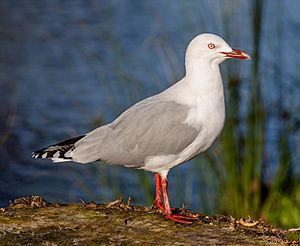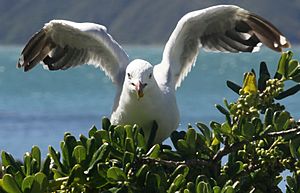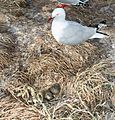Red-billed gull facts for kids
Quick facts for kids Red-billed gull |
|
|---|---|
 |
|
| Adult | |
| Conservation status | |
| Scientific classification |
|
| Kingdom: | Animalia |
| Phylum: | Chordata |
| Class: | Aves |
| Order: | Charadriiformes |
| Family: | Laridae |
| Genus: | Chroicocephalus |
| Species: | |
| Subspecies: |
C. n. scopulinus
|
| Trinomial name | |
| Chroicocephalus novaehollandiae scopulinus (Forster, 1844)
|
|
| Synonyms | |
|
Larus novaehollandiae scopulinus, Larus scopulinus |
|
The red-billed gull (Chroicocephalus novaehollandiae scopulinus) is a common bird found all over New Zealand. You can see them on the main islands and also on smaller islands like the Chatham Islands. This bird was once thought to be its own unique species. However, scientists now usually consider it a type of silver gull.
In the Māori language, this bird is called tarāpunga or akiaki. Sometimes, people might confuse it with the dolphin gull, which looks a bit similar but lives far away in places like Chile and Argentina. Red-billed gulls are often found near coastal towns and cities. They are known for being clever scavengers.
Scientists did a big study of red-billed gulls in New Zealand from 2014 to 2016. They counted about 27,831 pairs nesting. The study suggested that the number of these gulls has gone down since the 1960s. Scientists are now looking into why this might be happening and how to keep track of them better in the future.
Contents
What Does the Red-billed Gull Look Like?
The red-billed gull is a rather small bird. It has a bright red beak, red rings around its eyes, and red legs and feet. Its wings are light grey with black tips. The rest of its body and tail are white.
It's very hard to tell the difference between male and female red-billed gulls just by looking at them. Young gulls look a bit different. Their beaks are dark brown with only a little bit of red. This can make them hard to tell apart from young black-billed gulls. Young gulls also have brown legs and brown spots on their grey wings.
Where Do Red-billed Gulls Live?
This gull is the smallest type you commonly see in New Zealand. There are about 500,000 red-billed gulls in total. Even though they were once thought to be a separate species, they look a lot like the silver gull found in Australia. Because of this, they are now considered a type of silver gull.
How Do Red-billed Gulls Behave?

Red-billed gulls act like many other gulls. They are very active at finding food. They are good at scavenging, which means they look for food that others have left behind. They are also known as kleptoparasites. This means they sometimes steal food from other birds or animals!
Since people from Europe settled in New Zealand, the number of red-billed gulls has grown. This is especially true near cities and towns by the coast. Here, they can easily find food from human waste. Normally, they eat small fish, shellfish, and worms found in fields. They also sometimes eat berries, lizards, and insects.
Red-billed Gull Life Cycle
Red-billed gulls build their nests from October to December. They usually nest in large groups called colonies. These colonies are found along the coast, often on islands, rocky cliffs, or beaches.
These birds form strong pairs that stay together for many years. Before mating, the male bird often brings food to the female. This is an important part of their courtship. Their nests are well-built using things like seaweed, grasses, leaves, and ice plants.
Female gulls usually lay two or three eggs. The eggs can be brown or grey and have light and dark brown spots. A red-billed gull typically lives for about 12 years. However, some have been known to live much longer, even up to 30 years!
Gallery
-
Juvenile bathing, Picton, New Zealand
Images for kids
See also
 In Spanish: Chroicocephalus scopulinus para niños
In Spanish: Chroicocephalus scopulinus para niños













